- TOP
- Kanto
- Kanagawa(Hakone・Yugawara)
- Hakone・Miyanoshita Onsen
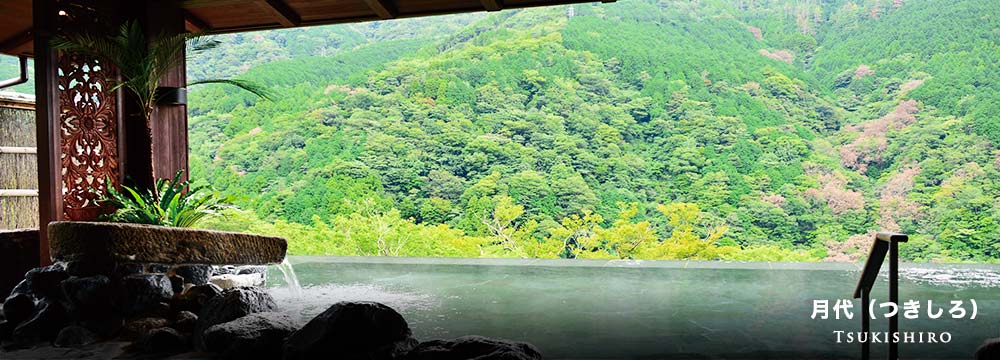
HAKONE-GINYU
| Sodium-Chloride Springs | pH |
|
| ナトリウム-塩化物泉(低張性 弱アルカリ性 高温泉) | ||
| (Hypotonic, Weak alkaline, High temperature Spring) | ||
Ideal for people like this
Who wants to test the skin beautifying effectWho has dry skin
Who wants to treat cuts quickly
Who are feeling stressed
Who has sensitivity to cold
- Address
- 100-1, Miyanoshita, Hakone-machi, Ashigarashimo-gun, Kanagawa-ken, 250-0404, JAPAN
〒250-0404 神奈川県足柄下郡箱根町宮ノ下100-1 - Calling from overseas
- +81-460-82-3355
- Calling from Japan
- 0460-82-3355

Official website

Hotel report
Hot Spring Power Chart (5-point scale)
※For Ginyu Spa’s private open-air bath
Passed Items of the Onsen Qualifications
4Points
| Temperature above 25℃ | 52.6℃ | Passed |
|---|---|---|
| Dissolved substances (excluding gaseous substances) over 1,000 mg/kg in total | 1,141mg/kg | Passed |
| Metasilicic acid over 50 mg/kg | 103mg/kg | Passed |
| Metaboric acid over 5 mg/kg | 14.8mg/kg | Passed |
Hydrogen Ion Concentration (pH)

- Comment
- Experience smoother skin by removing old keratin with these restorative waters!
7 Elements of Hot Springs for Beautiful Skin
Total4Points ※The number of points represents the quality of the spring called "hot water for beautiful skin.
| Skin cleansing effect | Skin reviving effect | Skin whitening effect |
|---|---|---|
| Hydrogen Carbonate Springs | Sulfate Springs | Sulfur Springs |
| Skin smoothing effect | Skin Coating and moisturizing effect | Skin moisturizing effect | Cleaning Effects |
|---|---|---|---|
| Alkaline | chloride | Metasilicic acid (100mg/kg) |
metaboronic acid (10mg/kg) |
Feel of the hot spring(5-point evaluation)
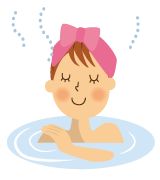
| Smoothly | Mushy | ||||||||||
|---|---|---|---|---|---|---|---|---|---|---|---|
| Powdery | Chewy | ||||||||||
| Fizzy | Tingle | ||||||||||
Effect after bathing(5-point evaluation)
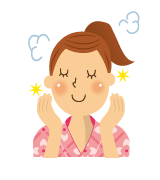
| Silky | Dryness | ||||||||||
|---|---|---|---|---|---|---|---|---|---|---|---|
| Powdery | Sticky | ||||||||||
| Moistly | Warmly | ||||||||||
View from the open-air bath(5-point evaluation)
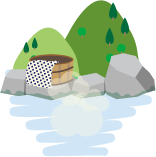
| Hakone mountain range |
| “Tsukishiro”, “Tsukine” |
| Point 5 |
|---|
Hot Spring Source Usage
| Water added | Heated | Disin fected | Circulated | Bath additive |
|---|---|---|---|---|
| Yes/No | Yes/No | Yes/No | Yes/No | No |
| *Large Public Bath/Public Open-air Bath・・・Circulated and disinfected while using water directly from the spring source. *Open-air Bath in the Guest Room・・・Circulated and disinfected (when the amount of hot water in the bathtub decreases, new water from the source is added) *Ginyu Spa private open-air bath・・・100% natural free-flowing hot spring |
||||
| Percentage of hot spring source | 98~100% | ||||
|---|---|---|---|---|---|
| Replacement frequency of hot spring water
|
Large Public Bath/Open-air Bath : Once every 2 days Open-air Bath in the Guest Room : Every day Ginyu Spa private open-air bath : Every day |
||||
| Spring Discharge Conditions | Private hot spring source 1: A hot spring well near our sister ryokan, Musashino Bekkan (90% used) Private hot spring source 2: A hot spring well along the national highway just before the Hakone Ginyu site as seen from Hakone Yumoto Station (10% used)...Water drawn from the above hot spring well (powered pump) |
||||
| Distance from the source to the bathtub | Private source 1...approx. 1km/Private source 2...approx. 200m | How hot spring water is drawn | Drawn by a pipe | ||
| How water temperature is adjusted | Large Public Bath/Open-air Bath, Open-air Bath in the Guest Room:Adjust the temperature by heating and adding water as needed. Ginyu Spa private open-air bath:Adjusting the hot water amount. |
||||
| Drinking Spring | Cannot *Non-submission of application for drinking to the health department | ||||
| “Gensen-Kakenagashi” Bath A hot spring bath supplied with water directly from the source without any alterations. |
Private open-air bath × 1 bath | ||||
Hot Spring Composition Table
| Spring Quality | Sodium - Chloride Springs (Hypotonic, weak alkaline, and High temperature spring) |
|---|---|
| Color of hot spring | Colorless and transparent |
| Scent of hot spring | Odorless |
| Dissolved substances | 1,141mg/kg(Sum of components (1) + (2) + (3), excluding gaseous substances) *About 11 times more components compared to bath additive! |
| Temperature of spring | 52.6℃ |
| pH | 8.4(weak alkaline) |
| Yield | About 120 liters per minute Amount of hot spring use per person (yield / bath capacity):About 1.6 liters/person (maximum capacity of 75 people) |
Hot Spring Composition (Amount contained in 1 kg of spring)
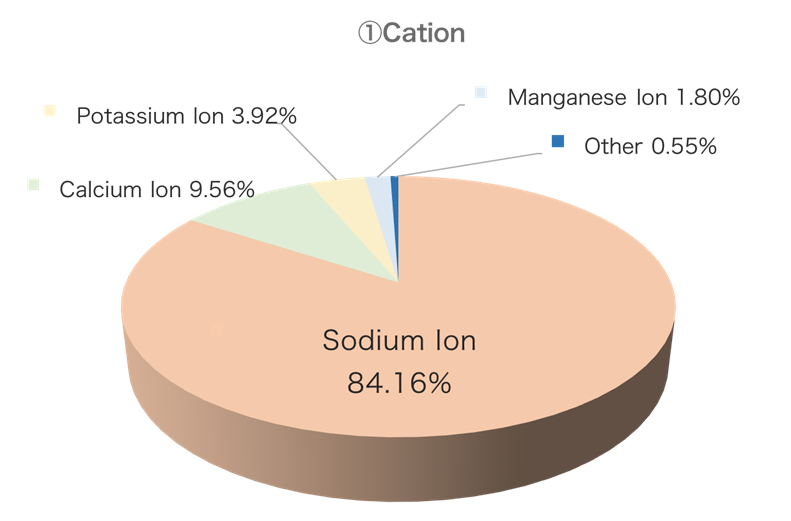 |
|||
|---|---|---|---|
| Cation | mg/kg | mval | mval% |
| Sodium Ion(Na+) | 321.0 | 13.94 | 84.16 |
| Calcium Ion(Ca2+) | 31.8 | 1.58 | 9.56 |
| Potassium Ion(K+) | 25.0 | 0.65 | 3.92 |
| Magnesium Ion(Mg2+) | 2.98 | 0.30 | 1.80 |
| Lithium Ion(Li+) | 0.45 | 0.09 | 0.54 |
| Strontium Ion(Sr2+) | 0.05 | 0.00 | 0.01 |
| Ferro Ion(Fe2+) | 0.17 | 0.00 | 0.00 |
| Aluminum Ion(Al3+) | 0.02 | 0.00 | 0.00 |
| Manganese Ion(Mn2+) | 0.06 | 0.00 | 0.00 |
| Zinc Ion(Zn2+) | 0.12 | 0.00 | 0.00 |
| Cations Total(1) | 381.65 | 16.56 | 100.00 |
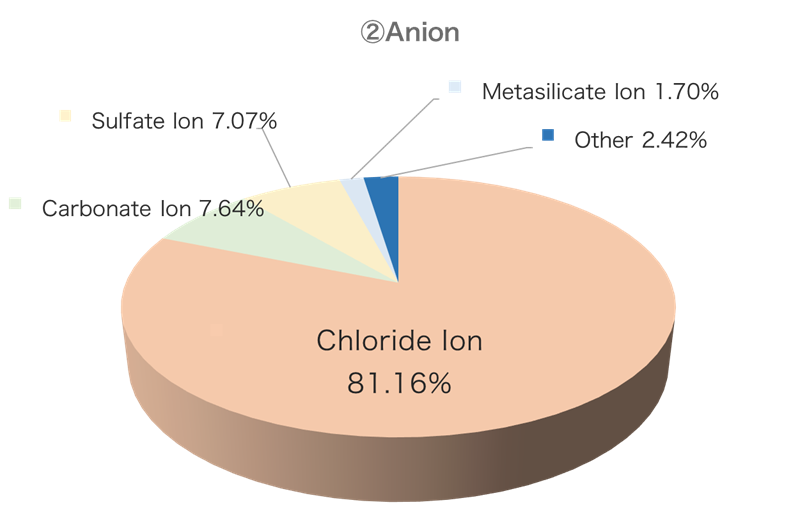 |
|||
|---|---|---|---|
| Anion | mg/kg | mval | mval% |
| Chloride Ion(Cl-) | 472.0 | 13.31 | 81.16 |
| Hydorogen carbonate Ion(HCO3-) | 76.1 | 1.25 | 7.64 |
| Sulfate Ion(SO42-) | 55.7 | 1.16 | 7.07 |
| Metasilicic acid Ion(HSiO3-) | 20.4 | 0.28 | 1.70 |
| Metaboric acid Ion(BO2-) | 9.11 | 0.21 | 1.27 |
| Carbonate Ion(CO32-) | 5.83 | 0.15 | 0.89 |
| Nitrate Ions(NO3-) | 1.58 | 0.02 | 0.15 |
| Bromide Ion(Br-) | 0.95 | 0.01 | 0.06 |
| Fluoride Ion(F-) | 0.14 | 0.01 | 0.05 |
| Anion Total(2) | 641.81 | 16.39 | 100.00 |
| Non-dissociated components | mg/kg | mmol | |
|---|---|---|---|
| Metasilicic Acid(H2SiO3) | 103.0 | 13.28 | |
| Metaboric Acid(HBO2) | 14.8 | 0.34 | |
| Total non-dissociated components(3) | 117.80 | 13.62 | |
| Dissolved gas components | mg/kg | mmol | |
|---|---|---|---|
| Free Carbon Dioxide(CO2) | 0.08 | 0.00 | |
| Total dissolved gas components(4) | 0.08 | 0.00 | |
| Other Trace Components | |||
|---|---|---|---|
| Copper Ion: 0.00 mg(Cu2+)/ kg, Lead Ion (Pb2+): 0.01 mg / kg, Cadmium Ion(Cd2+): 0.00 mg / kg, Total Arsenic(As): 0.568 mg / kg, Total Mercury(Hg): 0.000 mg / kg |
※The components in the yellow box are required to determine spring quality or to qualify as a hot spring (as defined in Japan).
Indications for Bathing (Revised on July 1, 2014)
Indications by Spring Quality for Bathing
Cuts, Peripheral circulatory disturbance, Cold sensitivity, State of depression, Dry skin
General Indications for Bathing
Chronic pain or stiffness of muscles or joints (chronic stages of rheumatoid arthritis, osteoarthritis, lower back pain, neuralgia, frozen shoulder, bruises, sprains, etc.),
muscle stiffness by motor paralysis, sensitivity to the cold, peripheral circulatory disturbance,
decline of gastrointestinal function (slow digestion, intestinal gas formation, etc.),
mild hypertension, impaired glucose tolerance (diabetes), mild hypercholesterolemia,
mild asthma or emphysema, hemorrhoidal pain, autonomic instability,
various symptoms from stress (sleep disorders, depression, etc.),
recovering from illness, recovery from fatigue, and promotion of health
Contraindications by Spring Quality for Bathing
None
General Contraindications for Bathing
Period of illness (especially when accompanied by fever), active tuberculosis,
advanced malignant tumor, or in cases of severe physical weakness, such as severe anemia,
severe cardiac or lung disease involving feelings of suffocation with little body movement,
severe kidney disease involving edema, gastrointestinal bleeding,
visible bleeding, and acute advanced stage of chronic disease
Indications by Spring Quality for Drinking
Atrophic gastritis, constipation *Not to be consumed because permission not obtained
The above indications and contraindications for hot springs were revised on July 1, 2014.
Date of Analysis (The above hot spring composition table is cited from the survey data of the following institution)
December 20, 2007 (Hot Springs Research Institute of Kanagawa)
- ※Indications and contraindications for hot springs are in accordance with "The Standard Methods of Analysis for Mineral Springs" revised on July 1, 2014.
- ※宿よりデータを提供して頂きました。
Hot Spring Legends and More
Traditionally documented efficacies
"Nanayu no Shiori", an Edo period guidebook on Hakone's seven hot springs, lists the efficacies of Miyanoshita Onsen as follows: Headache, stiffness in the shoulders, lower back pain, beriberi (disease resulting in heart failure and peripheral neuropathy), pain occurring in the abdomen and chest, hemiplegia or paralysis in the hands and legs occurring from cerebral hemorrhage, colic, muscle and joint pain, leg cramps, asthma, dizziness, blood clots, bruises, hemorrhoids, sprains, and vaginal discharge.
Historical figures who bathed in this hot spring
U.S. Army General Douglas MacArthur (1880-1964), U.S. President Dwight D. Eisenhower (1890-1969), comedian Charles Chaplin (1889-1977), social activist Helen Keller (1880-1968), musician John Lennon (1940-1980), and many others.
Hot Spring (Onsen) Report
“Hakone Ginyu”, nestled in Hakone Miyanoshita Onsen area, draws its waters from two private hot spring sources. One source is a spring well located about 200 meters from the inn, and the other is near its sister facility, “Musashino Bekkan”, approximately 1 kilometer away.
The spring quality of Hakone Ginyu is sodium-chloride springs with weak alkalinity (pH 8.4).
First of all, note that it is weak alkaline.
Because human skin is generally slightly acidic, soaking in alkaline hot springs dissolves old cuticles on the skin and makes it feel smooth. Because of this property, hot springs that are (weak) alkaline are called “hot springs for beautiful skin (bihada-no-yu)”.
It should not be overlooked that it is a chloride spring, that is, a hot spring that contains salt.
Indications by spring quality of chloride springs include cuts, peripheral circulatory disturbance, sensitivity to cold, depression, and dry skin.
When you soak in a hot spring containing salt, the salt covers your body like a pack. This pack blocks the sweat glands (organs that secrete sweat), so the body temperature drops slowly after bathing, and the feeling of warmth continues for a long time.
For this reason, “Chloride spring” is also called “Hot springs for warmth”. Sensitivity to cold can be recognized as an indication for other springs also, but the “Chloride spring” is particularly effective.
At the same time, the warming feeling that continues for a long time will help improve Peripheral circulatory disturbance. This salt pack also reduces skin dryness after the bath due to the coating effect of hot spring components and their moisturizing effect.
The effect of sustained warmth helps to balance autonomic nervous system and brings about a sense of mental stability. Also, increased body temperature reduces the secretion of stress hormones, which may contribute to mood improvement and have a positive effect on Depression.
Also, after bathing in hot springs that remove dead skin cells, such as (Weak) Alkaline simple hot springs, Hydrogen carbonate springs, Sulfate springs, and Sulfur springs, which are so-called “Hot springs for beautiful skin”, then bathing in “Chloride spring” is also called “Hot springs for finishing touch” due to its salt coating & moisturizing effects. It is also called “Hot springs for cuts” “because of the bactericidal effect of its salt content, which is effective against Cuts and burns.
Also note the metasilicic acid. This is because it contains 103 mg of metasilicic acid per kilogram of spring water.
According to the Japanese hot spring standard, hot springs must contain 50 mg or more of metasilicic acid per 1 kg of spring water to be approved as a hot spring.
This means that this hot spring contains more than twice the standard value (50 mg) of metasilicic acid.
It is said to be a natural moisturizer and is sometimes used as an ingredient in lotion.
One of the conditions for being called “hot springs for beautiful skin (bihada-no-yu)” is that it contains an abundance of metasilicic acid.
This spring also contains 14.8 mg of metaboric acid, which is also nearly three times the Japanese hot spring standard value (5 mg).
Metaboric acid has a cleansing effect on the skin and is thought to be effective in treating skin problems such as acne.
It also has antibacterial properties and is used as an ingredient in eye drops.
At this inn, the large public baths and the private open-air baths in guest rooms utilize a circulation and sterilization system. However, the baths in the esthetic treatment facility “Ginyu Spa” are 100% natural hot spring, flowing directly from the source without any circulation or additives.
Although “Ginyu Spa” is primarily reserved for spa treatment guests, it can be exclusively rented at night by a single group per day, offering a luxurious private experience.
If you want to fully experience the power of the hot spring, these baths come highly recommended. As mentioned earlier, the hot spring water here gently envelops the body like a natural beauty mask, making it the perfect finishing touch after a spa treatment.
Even in the areas where sterilization is used, the inn doesn't rely on standard chlorine-based chemicals like many other ryokan. Instead, it uses a multifunctional sterilization device that incorporates silver-infused ceramics.
This advanced system not only eliminates aerobic bacteria, including Legionella, which causes sliminess, but also breaks down chlorine and nitrogen compounds, preventing the formation of harmful substances such as trihalomethanes and dioxins.
If disinfection is carried out this thoroughly even in large public baths used by a wide range of people, everyone, regardless of age or gender, can bathe with peace of mind.
| Ginyu Spa private open-air bath | Open-air bath and inner bath in the guest room “Meigetsu” |
|---|---|
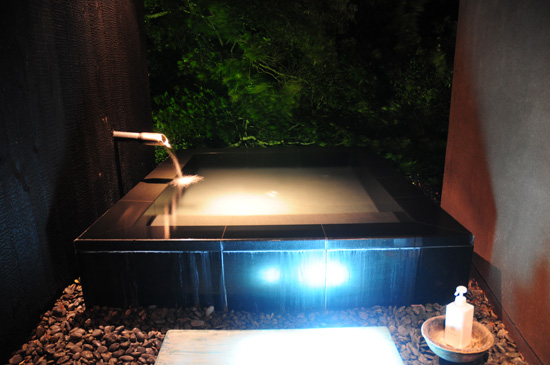 |
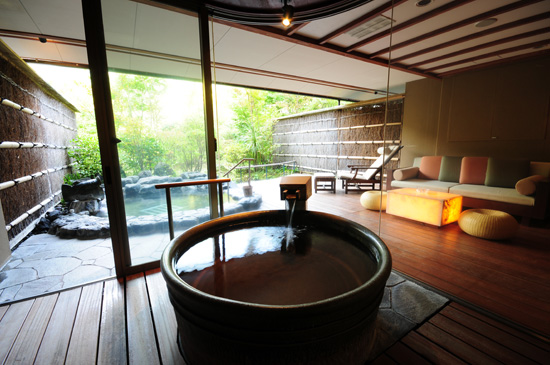 |
| This is the only bathtub in the inn with 100% free-flowing hot spring from the source. During the day, it is used by esthetic customers, but at night, the entire esthetic facility can be rented out to one group per day. Every place in the private open-air bath is lit up, including the trees, creating a fantastic atmosphere. |
All of the 20 guest rooms are equipped with an open-air bath. Since the inn is built to cling onto a cliff, you can enjoy the view of the Hakone mountain range from the open-air bath in any room. In addition to the open-air bath, there is also an indoor bath booth surrounded by transparent acrylic panels. |
| Open-air bath in the guest room “seishuku” | Large Public Open-air Bath and Inner Bath “Tsukishiro” |
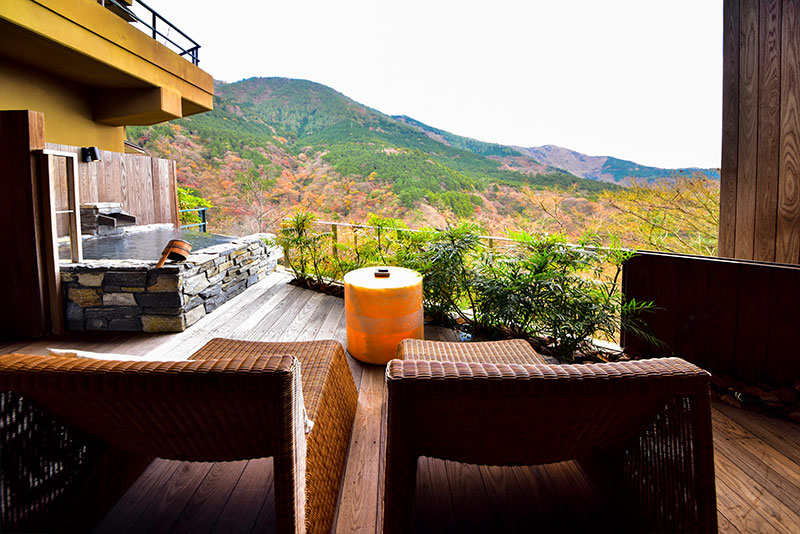 |
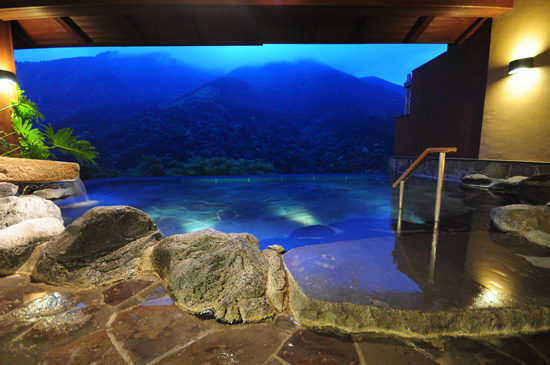 |
| The inn has one maisonette-type guest room available. The view from the rooms utilizes the advantages of corner rooms, and bathing in the hot water with a view of the Hakone mountain range offers an outstanding sense of freedom. The sofa on the terrace also adds to the resort atmosphere. | There are two large baths for female and male guests that interchange depending on the time of day. Large public open-air bath "Tsukishiro" is also known as an "infinity open-air bath" because the edge of the bathtub and the handrails are all invisible from your sight when you soak in. You feel like floating on the air. |
Facility Report
“Hakone Ginyu”, located in Hakone Miyanoshita Onsen, is a popular hot spring inn(Japanese onsen ryokan) that often described as “a Japanese inn that is difficult to book” by various media.
The exotic atmosphere of Miyanoshita onsen resort and the oriental style of Japanese onsen ryokan simply matched perfectly.
Looking out from the inn, the view of the Hakone mountain range is magnificent; gaze at and you will find it looks like a greenish mossy garden.
Or, like an island in a vast ocean.
Both dinner and breakfast are basically served in the guest rooms.
You can enjoy kaiseki ryori (one type of Japanese course meal), in which the ingredients are carefully selected to give a sense of the goodness of Japan.
For breakfast, you can choose between Japanese and Western food, which is a nice touch.
After this inn was born, people in the inn industry came to inspect it, learning about its great success, and similar inns were created all over Japan.
However, after all, they cannot surpass the original Hakone Ginyu.
This is because Hakone Ginyu is the pioneer who created the current trend of Japanese inns by adding a superb view and hospitality to all rooms having an open-air bath.
Rates Data
| Room with two meals | From 38,650 yen per night(without tax) |
|---|---|
| Room with breakfas | Not available |
| Overnight stay without meals | Not available |
| Rates for one person (room with two meals) | From 58,450 yen per night |
| Private bath rates for hotel guests | Included in the price of Ginyu Spa |
| Without stay rates | Not available |
| Use of private bath without stay | Not available |
Facility Data
| Founded in | 1951 |
|---|---|
| Check in | 2:00 PM |
| Check out | 11:00 AM |
| Location of the inn | Environment of the inn Mountains, ravines, and gardens |
| Number of rooms | 20 rooms total 17 Japanese-style rooms, 3 Japanese-Western style rooms - All 20 rooms have an open-air bath |
| Capacity | 75 people |
| Parking | 15 cars |
| Facilities | Lounge, cafe, bar, spa, and store |
| Internet | Wi-Fi available throughout the building |
| Handicapped-accessible rooms | Partly Supported |
| Toilet with shower | Equipped |
Transportation Access
| By train | A 3-minute walk from Miyanoshita Station on the Hakone Tozan Railway |
|---|---|
| By bus | A minute walk from the Miyanoshita bus stop on the Hakone Tozan Bus |
| Shuttle bus | None |
| By car | Odawara-Atsugi Road → National Route 1 → Miyanoshita → Hakone Ginyu (about 20 minutes from Odawara West IC) |
| Address | Kanagawa Prefecture/Hakone, Miyanoshita Onsen/Hakone Ginyu 100-1, Miyanoshita, Hakone-machi, Ashigarashigashimo-gun, Kanagawa, 250-0404, Japan |
- Data
- 2023/09/13


